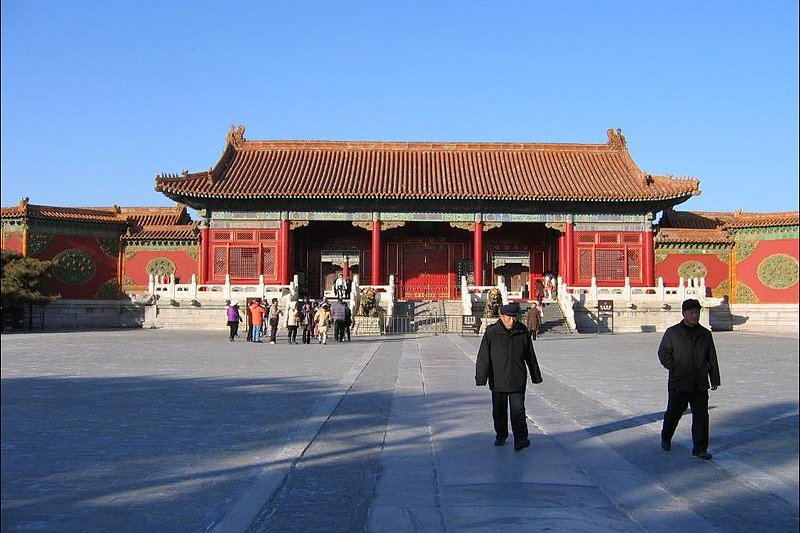 Forbidden City, Beijing
Forbidden City, BeijingSource: https://commons.wikimedia.org/wiki/File:20090528_Beijing_Forbidden_City_7745.jpg
Author: Jakub Halun

Beijing is the capital and second largest city in China. Comprising 16 district and 2 counties, it covers 16,801.25 sq km (6,487 sq mi) and has a population of 19.6 million people. The city is situated in northern China. It is surrounded by mountains on the north, northwest and western part, separating it from the barren desert steppes. Major waterways in Beijing include the Yongding River, Chaobai River and the Grand Canal, which links Beijing with Hangzhou.
Beijing experiences a humid continental climate with hot, humid summers and cold, dry winters. July is the hottest month here, with average high temperatures of 30.9°C (87.6°F), while January is the coldest month, with average low temperatures of -8.4°C (16.9°F). July is also the wettest month, receiving 185.2 mm (7.3 in) of precipitation.
Beijing is prone to smog, the result of bad air quality cause by polluting industries from the surrounding region. The city took on drastic steps to improve its air quality in the run-up to the 2008 Summer Olympics, including closing some gas stations, limiting traffic on the road and so on. It resulted in the best air quality in a decade, though still high by international standards. The city still suffers from smog quite frequently.
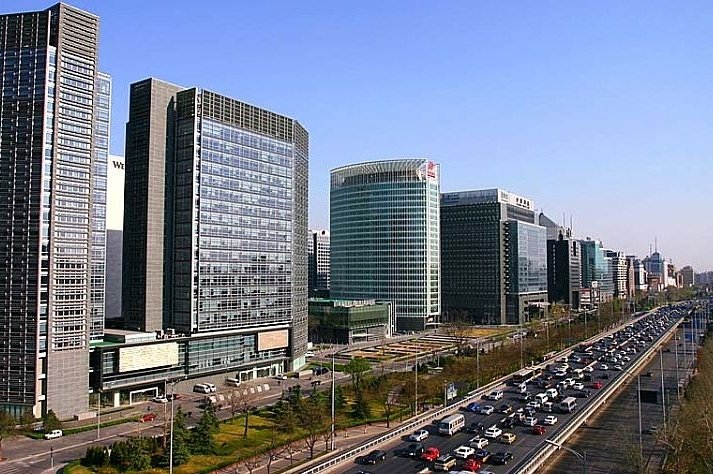 Beijing Financial Street
Beijing Financial Street
Author: Jakub Halun

Beijing is the capital and second largest city in China. Comprising 16 district and 2 counties, it covers 16,801.25 sq km (6,487 sq mi) and has a population of 19.6 million people. The city is situated in northern China. It is surrounded by mountains on the north, northwest and western part, separating it from the barren desert steppes. Major waterways in Beijing include the Yongding River, Chaobai River and the Grand Canal, which links Beijing with Hangzhou.
Beijing experiences a humid continental climate with hot, humid summers and cold, dry winters. July is the hottest month here, with average high temperatures of 30.9°C (87.6°F), while January is the coldest month, with average low temperatures of -8.4°C (16.9°F). July is also the wettest month, receiving 185.2 mm (7.3 in) of precipitation.
Beijing is prone to smog, the result of bad air quality cause by polluting industries from the surrounding region. The city took on drastic steps to improve its air quality in the run-up to the 2008 Summer Olympics, including closing some gas stations, limiting traffic on the road and so on. It resulted in the best air quality in a decade, though still high by international standards. The city still suffers from smog quite frequently.
 Beijing Financial Street
Beijing Financial StreetSource: https://commons.wikimedia.org/wiki/File:2007-10-11-BJFS.JPG
Author: CobbleCC

The cheapest way to reach the city is to take the Airport Shuttle Bus. There are five routes. The fare is RMB16. To go even cheaper, take public bus 359. It runs from Airport to Dongzhimen. From there, you can take subway lines 2 or 13 to reach other parts of Beijing.
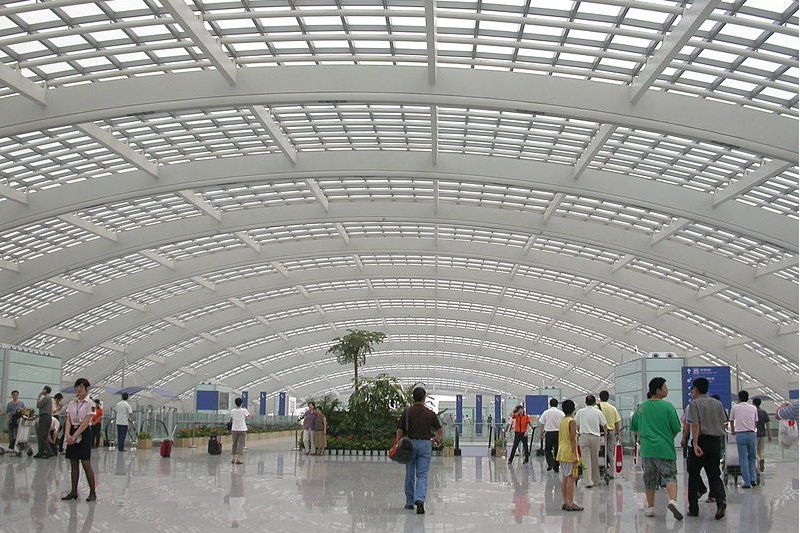 Terminal 3, Beijing Capital International Airport
Terminal 3, Beijing Capital International Airport
Author: CobbleCC

Places of Interest in Beijing
I mark a star ( * ) for sights of considerable significance, and two stars ( * * ) for sights of major significance. Also, if it's a considerable distance from Beijing city center, I mark it with a hash ( # )- Ancient Observatory
- Badachu Park
- Bei Hai Park
- Beijing Botanical Garden *
- Beijing Museum of Natural History
- Beijing Zoo
- Chinese Military History Museum
- Chuandixia * #
- Confucius Temple
- Cow Street Mosque
- Dazhalan & Liulichang
- Di Tan Park
- Dong Yue Miao
- Drum & Bell Towers
- Eastern Qing Tombs * #
- Fayuan Temple
- Forbidden City * *
- Great Bell Temple
- Jing Shan Park
- Lama Temple
- Mansion of Prince Gong
- Marco Polo Bridge
- Miaoying Temple
- Ming Tombs of Chang Ling * #
- National Art Museum of China
- National Olympic Stadium *
- Peking Man Site at Zhoukoudian #
- Qian Men
- South Cathedral
- Southeast Corner Watchtower
- St Joseph's Church
- Tanzhe Temple #
- Tiananmen Square *
- Underground City
- Wangfujing Street
- White Clouds Temple
- Xiang Shan Park
- Yuanming Yuan
Arriving in Beijing
The Beijing Capital International Airport (PEK) is the airport serving the city. Located 26 km to the northeast of downtown Beijing, it presently has three terminals. Terminal 1 serves Hainan Airlines; Terminal 2 serves China Southern Airlines, China Eastern Airlines and Skyteam; Terminal 3 serves Air China, Shanghai Airlines, Oneworld, Star Alliance and Finnair.The cheapest way to reach the city is to take the Airport Shuttle Bus. There are five routes. The fare is RMB16. To go even cheaper, take public bus 359. It runs from Airport to Dongzhimen. From there, you can take subway lines 2 or 13 to reach other parts of Beijing.
 Terminal 3, Beijing Capital International Airport
Terminal 3, Beijing Capital International AirportSource: https://commons.wikimedia.org/wiki/File:The_station_of_Terminal_3_of_Capital_Airpor.JPG
Author: snowyowls

The new Terminal 3 is massive. Due to its size, you need adequate time to reach your gate. Check-in closes 45 minutes before flight. A free shuttle bus connects Terminal 3 with Terminal 2. It departs every 10 minutes and takes another 10 minutes to make the journey.
Terminals 1 and 2 are connected by a corridor with travelators. Expect at least 10 minutes to navigate between the two terminals.
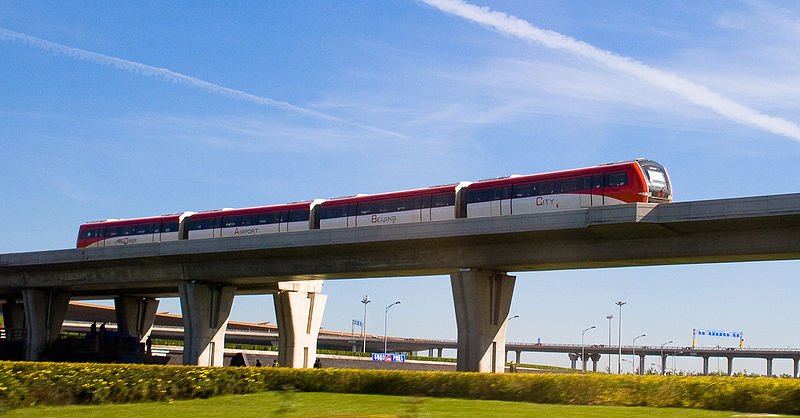 Airport Express Train
Airport Express Train
Author: snowyowls

Departing from Beijing
If you are going to the airport from Beijing, be sure you know from which terminal your flight is departing. You can take the Airport Express train from Sanyuanqiao Station and Dongzhimen Station to Terminal 3 or Terminal 1/2. The fare is RMB25 regardless which station you board (even if you take it from Terminal 3 to Terminal 1 or 2). Taxi fare from downtown Beijing to airport costs about RMB100.The new Terminal 3 is massive. Due to its size, you need adequate time to reach your gate. Check-in closes 45 minutes before flight. A free shuttle bus connects Terminal 3 with Terminal 2. It departs every 10 minutes and takes another 10 minutes to make the journey.
Terminals 1 and 2 are connected by a corridor with travelators. Expect at least 10 minutes to navigate between the two terminals.
 Airport Express Train
Airport Express TrainSource: https://commons.wikimedia.org/wiki/File:Beijing_Subway_Airport_Express_01.jpg
Author: karismafilms

If you have the money for it, by all means take the taxi. Fare starts at RMB10 for the first 3 km, and then it's RMB2 for every subsequent kilometer. Make sure the driver turns on the meter. Point to it if you see it isn't reset. At your destination, ask for a receipt by pointing to the meter and make a gesture of writing. You can also hire a taxi for the whole day of between RMB400 to RMB600.
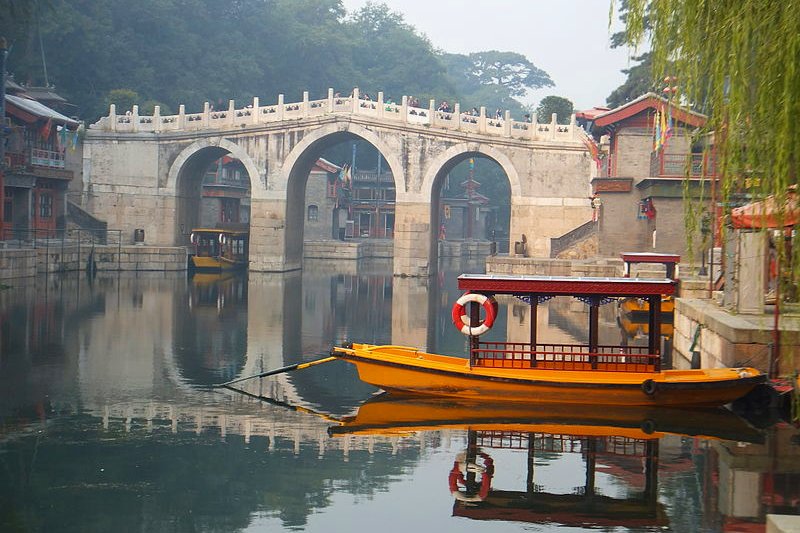 Boat at Suzhou Market Street, Summer Palace, Beijing
Boat at Suzhou Market Street, Summer Palace, Beijing
Author: karismafilms

Getting Around Beijing
The most practical way to get around Beijing is to take the subway. There are now nine subway lines in operation, with another nine expected to be operational within the next few years. If this is going to be your main mode of transport, get the pre-paid card, called Yikatong. You pre-pay the fare, including a refundable deposit of RMB20 for the eard. Just swipe it over the turnstile to access the subway platform, and again as you exit it.If you have the money for it, by all means take the taxi. Fare starts at RMB10 for the first 3 km, and then it's RMB2 for every subsequent kilometer. Make sure the driver turns on the meter. Point to it if you see it isn't reset. At your destination, ask for a receipt by pointing to the meter and make a gesture of writing. You can also hire a taxi for the whole day of between RMB400 to RMB600.
 Boat at Suzhou Market Street, Summer Palace, Beijing
Boat at Suzhou Market Street, Summer Palace, BeijingSource: https://commons.wikimedia.org/wiki/File:Suzhou_Reflections.jpg
Author: Kit Rawson

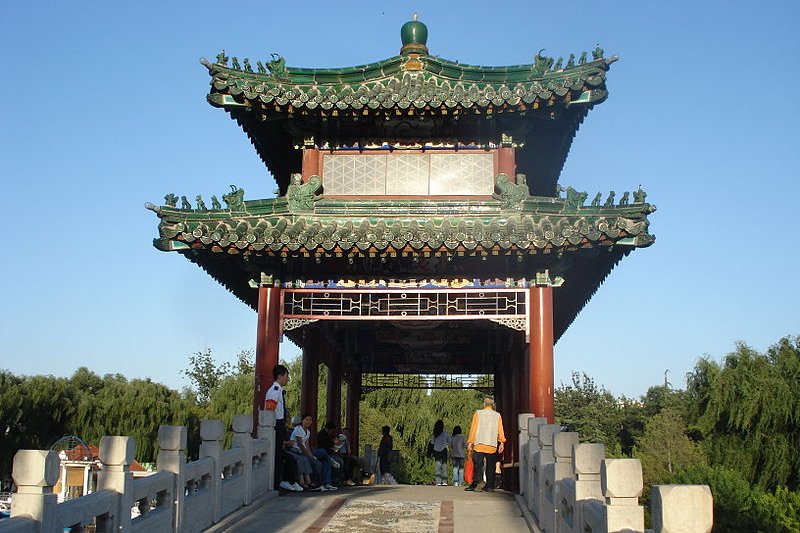 Longtan Park, Beijing
Longtan Park, Beijing
Author: Kit Rawson

World Heritage Sites in and around Beijing
- Great Wall of China * * #
- Summer Palace **
- Temple of Heaven **
 Longtan Park, Beijing
Longtan Park, BeijingSource: https://commons.wikimedia.org/wiki/File:Longtan_Park_pic_2.jpg
Author: Ivan Walsh

Looking for information on Penang? Use this Map of Roads in Penang to zoom in on information about Penang, brought to you road by road.

Author: Ivan Walsh

 Latest updates on Penang Travel Tips
Latest updates on Penang Travel Tips
 Map of Roads in Penang
Map of Roads in Penang
Looking for information on Penang? Use this Map of Roads in Penang to zoom in on information about Penang, brought to you road by road.
Copyright © 2003-2025 Timothy Tye. All Rights Reserved.

 Go Back
Go Back